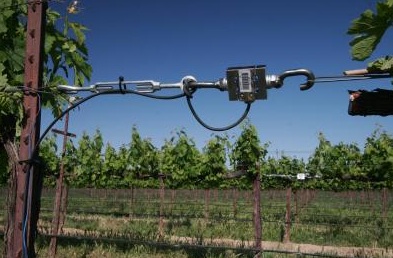
 November 6, 2009, Prosser,
November 6, 2009, Prosser,
WA – Grape producers may soon have access to a dynamic tool to estimate yield
called Trellis Tension Monitor (TTM).
November 6, 2009, Prosser,
WA – Predictions of grape yields are extremely important to juice processors
and wineries; timely and precise yield forecasts allow producers to plan for
harvest and move the highly perishable grape crop from vine to processing
efficiently. Until recently, wineries and grape juice processors have relied on
expensive and labour-intensive hand-sampling methods to estimate yield in grape
crops.
 |
|
| Trellis Tension Monitoring (TTM) assembly (center) in line with the main trellis wire in a wine grape vineyard. The row in the background also contains a TTM assembly (toward right). |
Thanks to extensive
research efforts, grape producers may soon have access to a dynamic tool to
estimate yield called Trellis Tension Monitor (TTM). TTM allows for real-time
monitoring of plant growth and predicting yield in trellised crops. Simply put,
TTM technology works by detecting weight change on trellised grapevines as the
vine and grapes grow. Data recorded by the TTM electronic monitoring system can
be used to predict crop yields, enabling growers to create more efficient
timetables for grape-picking operations.
To support their previous
work and further investigate the effectiveness of TTM, researchers Julie M.
Tarara and Paul E. Blom of the USDA-Agricultural Research Service’s
Horticultural Crops Research Unit in Prosser, Washington, and colleagues from
the University of Idaho and Washington State University, undertook a
groundbreaking five-year study of TTM. Two recent reports of Tarara and Blom’s
research were published in the American Society for Horticultural Science’s
journal, HortScience.
“The objective of our
research was to assess the dynamics of fruit and shoot fresh weight in
grapevines trained to a single curtain, within and between seasons of a wide range,
to develop functional relationships of expected responses to improve the
potential for meaningful interpretation of TTM data in vineyards,” stated
Tarara.
Measurements of shoot and
fruit fresh mass in Concord grapevines were collected at intervals of 14 to 21
days over five years in research vineyards in Washington state. Data were
correlated with variables including shoot length, number of leaves per shoot,
and number of clusters per shoot.
Using 10 commercial
vineyards, the researchers found that TTM produced more-accurate estimates of
yield in most vineyards than did the standard processor protocol. No subjective
inputs were allowed, which otherwise would be the case in commercial practice
“The TTM method could
replace traditional, manual methods of yield estimation or could be used in
conjunction with processors’ and wineries’ traditional approaches to increase
the amount of real-time information and provide data for revising yield
estimates right up to harvest,” said Tarara.
Print this page